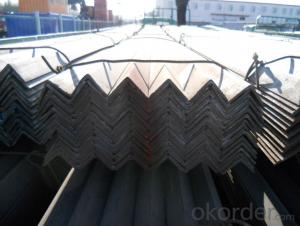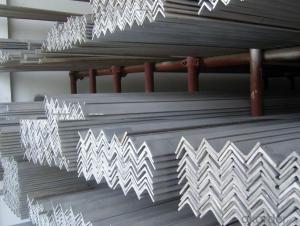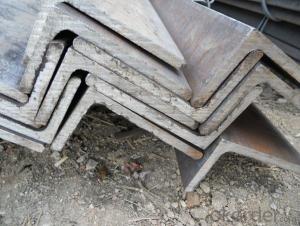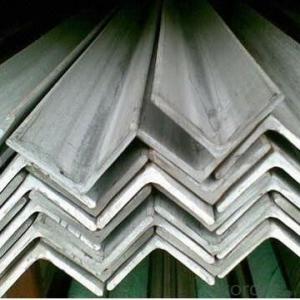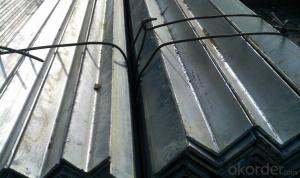Equal Steel Angle GB Standard
OKorder Service Pledge
OKorder Financial Service
You Might Also Like
Specifications of Equal Angle Steel
1.Standards:GB
2.Length:6m,9m,12m
3.Material:GBQ235,Q345 or Equivalent
4. Size:
Size (mm) | Mass (mm) | Size (mm) | Mass (mm) |
| 30*30*5 | 2.184 | 38*38*2.5 | 1.482 |
| 30*30*6 | 2.564 | 38*38*3 | 1.758 |
Usage & Applications of Equal Anlge Steel
Trusses;
Transmission towers;
Telecommunication towers;
Bracing for general structures;
Stiffeners in structural use.
Packaging & Delivery of Equal Angle Steel
1. Transportation: the goods are delivered by truck from mill to loading port, the maximum quantity can be loaded is around 40MTs by each truck. If the order quantity cannot reach the full truck loaded, the transportation cost per ton will be little higher than full load.
2. With bundles and load in 20 feet/40 feet container, or by bulk cargo, also we could do as customer's request.
3. Marks:
Color mark: There will be color marking on both end of the bundle for the cargo delivered by bulk vessel. That makes it easily to distinguish at the destination port.
Tag mark: There will be tag mark tied up on the bundles. The information usually including supplier logo and name, product name, made in China, shipping marks and other information request by the customer.
If loading by container the marking is not needed, but we will prepare it as customer request.
*If you would like to get our price, please inform us the size, standard/material and quantity. Thank you very much for your attention.
- Q: Can steel angles be used for framing in residential construction?
- Certainly, steel angles have the potential to be utilized for framing purposes in residential construction. Due to their robustness and longevity, steel angles are commonly employed as vital components in construction projects. They can provide essential reinforcement and stability in various framing applications, such as wall framing, roof trusses, and floor joists. When it comes to residential construction, steel angles possess numerous advantages. They exhibit remarkable resistance against warping, shrinking, and rotting, rendering them an exceptionally dependable choice for framing purposes. Furthermore, steel angles have the added benefit of being fire-resistant, offering an additional layer of safety in residential structures. Ultimately, steel angles represent a versatile and cost-effective alternative for framing endeavors in residential construction projects.
- Q: What are the standard lengths for steel angles?
- Steel angles come in a range of standard lengths, which can vary depending on the manufacturer and project requirements. Commonly available options include 20 feet, 30 feet, and 40 feet. Additionally, it is worth mentioning that steel angles can be custom cut to fit specific application needs.
- Q: Can steel angles be used in the construction of government buildings?
- Government buildings can indeed utilize steel angles for construction purposes. The strength and durability of steel angles make them a prevalent choice in building construction. Their ability to provide stability and support to the overall structure deems them appropriate for government buildings, which require sturdy and long-lasting construction materials. Furthermore, the versatility of steel angles allows for easy fabrication and customization, meeting the specific design requirements of various architectural and structural applications within government buildings.
- Q: Can steel angles be used in mezzanine or raised platform constructions?
- Mezzanine or raised platform constructions can incorporate steel angles, which are flexible structural elements capable of providing support and stability in construction projects. Due to their strength and ability to bear heavy loads, steel angles are frequently utilized as framing members in mezzanine or raised platform structures. Their connection to other steel components like beams and columns is effortless, enabling the creation of a robust framework for the mezzanine or raised platform. Moreover, steel angles can serve as bracing and reinforcement elements, thereby enhancing the structure's overall stability and safety. In summary, steel angles are a commonly chosen option for mezzanine or raised platform constructions due to their durability, versatility, and cost-effectiveness.
- Q: How do you calculate the stability factor of a steel angle?
- The stability factor of a steel angle is calculated by dividing the Euler buckling load by the applied compressive load.
- Q: What are the different methods of surface preparation for painting steel angles?
- Some different methods of surface preparation for painting steel angles include abrasive blasting, chemical cleaning, and power tool cleaning. Abrasive blasting involves using high-pressure air or water to propel abrasive materials onto the surface of the steel angle, removing any rust, scale, or other contaminants. Chemical cleaning involves applying specific chemicals to the steel angle to dissolve or remove any contaminants. Power tool cleaning involves using power tools such as grinders or sanders to mechanically remove any rust, scale, or other contaminants from the surface of the steel angle.
- Q: Can steel angles be used in railway infrastructure?
- Yes, steel angles can be used in railway infrastructure. Steel angles, also known as L-shaped structural steel, have a variety of applications in the construction industry, including railway infrastructure. They are commonly used in the fabrication of railway tracks, bridges, support structures, and other components of the railway system. Steel angles are preferred in railway infrastructure due to their high strength, durability, and versatility. They can withstand heavy loads and provide excellent structural support, making them suitable for the demanding conditions of railway tracks and structures. Steel angles are also resistant to corrosion, which is crucial for railway infrastructure exposed to harsh environmental conditions. In railway tracks, steel angles are often used as base plates, connecting the rails to the sleepers or ties. They provide stability and distribute the load evenly, ensuring the safe and smooth operation of trains. Steel angles are also used in the construction of bridges, where they serve as the main structural element for supporting the weight of the trains. Furthermore, steel angles can be easily fabricated and installed, making them a cost-effective choice for railway infrastructure projects. They can be cut, welded, and shaped to meet specific design requirements, allowing for efficient construction and customization. Overall, steel angles have proven to be a reliable and efficient choice for railway infrastructure. Their strength, durability, and versatility make them suitable for various applications in the railway system, contributing to the safety and efficiency of train operations.
- Q: Can steel angles be used for pipe supports?
- Yes, steel angles can be used for pipe supports. Steel angles provide a strong and durable option for supporting pipes due to their structural integrity and load-bearing capabilities. The L-shaped design of steel angles offers excellent stability and can be easily mounted to walls, ceilings, or other structural elements. Additionally, steel angles can be welded or bolted together to create custom configurations that suit specific pipe support requirements. Their versatility, strength, and ease of installation make steel angles a popular choice for pipe support applications in various industries such as construction, plumbing, and manufacturing.
- Q: Can steel angles be used as a support for shelving?
- Yes, steel angles can be used as a support for shelving. Steel angles are strong and durable and can provide excellent support for shelves. They are commonly used in industrial settings and heavy-duty applications where a strong and stable shelving system is required. Steel angles can be easily attached to walls or other structures to create a framework for shelves or can be used as brackets to support the shelves directly. Their sturdy construction and load-bearing capacity make them a reliable choice for supporting shelving units.
- Q: Can steel angles be used in bridges?
- Indeed, bridges can utilize steel angles. Due to their versatility and structural strength, steel angles are frequently employed in bridge construction. They can serve as the primary framework, offer support and reinforcement, as well as connect various structural elements. The ease with which steel angles can be welded or bolted to other steel components makes them particularly advantageous for bridge construction, facilitating efficient and long-lasting construction. Moreover, steel angles exhibit exceptional resistance to corrosion, rendering them suitable for bridges exposed to severe environmental conditions. All in all, incorporating steel angles into bridge designs proves to be a dependable and cost-effective decision.
Send your message to us
Equal Steel Angle GB Standard
OKorder Service Pledge
OKorder Financial Service
Similar products
Hot products
Hot Searches
Related keywords
